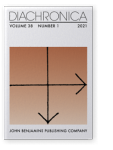Vol. 38:1 (2021) ► pp.64–110
The evolution of consonant mutation and noun class marking in Wolof
This paper analyzes the origins and evolution of the Wolof (Atlantic: Senegal) consonant mutation and noun class marking systems. I attribute Wolof mutation to the earlier presence of CV(C)- class prefixes on nouns, the (usually final) consonants of which fused with the following root-initial consonant to yield the modern mutation alternations. I reconstruct these original class prefixes using newly-proposed internal and comparative evidence, drawing on early documentary sources dating from the late 17th century. An understanding of the history of Wolof mutation allows for a better account of the synchronic system, in which mutation is triggered by specific noun classes rather than sporadically marking deverbal derivation. This study contributes to the broader understanding of how consonant mutation systems emerge and evolve, and of phonological considerations in noun class assignment.
Article outline
- 1.Introduction
- 2.Background
- 2.1The Wolof language
- 2.1.1Sources
- 2.1.2Phoneme inventory and phonotactics
- 2.2Consonant mutation
- 2.1The Wolof language
- 3.The Wolof noun class system
- 3.1The classes and their semantics
- 3.2Exponence of noun class
- 3.2.1On determiners
- 3.2.2Before nouns
- 3.2.3Fossilized on nouns
- 3.3Class assignment based on initial consonant
- 4.Wolof initial consonant mutation
- 4.1Deverbal mutation
- 4.2Diminutive and other denominal mutation
- 4.3Association of individual classes with mutation (including for underived nouns)
- 4.4Singular/plural mutation
- 4.5Voiceless prenasalized sounds and the nominal prefix k- in older sources
- 4.6Fortition induced by b- and diminutive s-
- 4.7The possibility of other alternations
- 4.8Comparison with existing proposals
- 5.History of the noun class system
- 5.1The individual classes
- 5.1.1b-
- 5.1.2y-
- 5.1.3g(N)-
- 5.1.4j-
- 5.1.5mN-
- 5.1.6sN-
- 5.1.7w-
- 5.1.8lN-
- 5.1.9k-
- 5.1.10ñ-
- 5.2Historical shape of the class markers: Summary
- 5.1The individual classes
- 6.Conclusion
- Acknowledgements
- Notes
-
References
